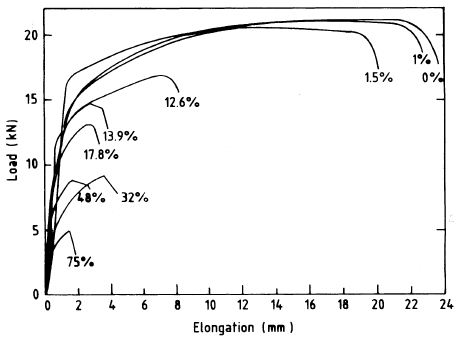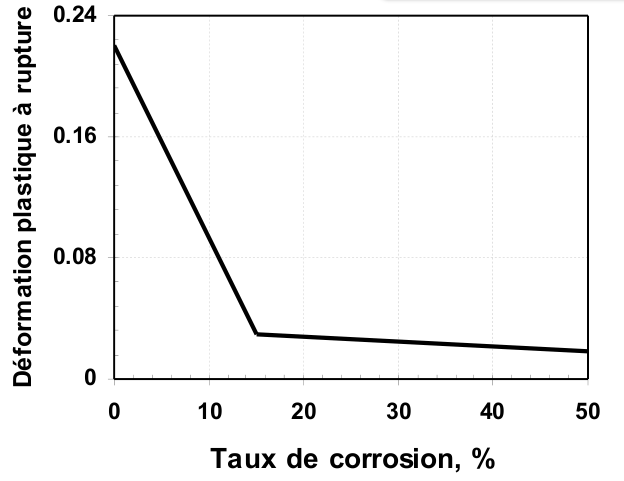2. Benchmark solution#
2.1. Calculation method#
The reference solution consists of the results of tensile tests carried out on corroded bars (the initial diameter is \(6\mathrm{mm}\)). Following these tests, a decrease in plastic deformation at break with an increase in the degree of corrosion is observed.
2.2. Benchmark results#
Evolution of the plastic deformation at break of corroded bars as a function of the degree of corrosion (the reduction in the diameter of bars or the thickness of flat reinforcement compared to non-corroded ones) is presented on the [Figure 2.2-a] and the [Figure 2.2-b].

Figure 2.2.a Influence of corrosion on the behavior of steel as a function of the corrosion rate

Figure 2.2.b Evolution of plastic deformation at break as a function of corrosion rate
2.2.1. Flexural modeling with thermal expansion#
By placing itself at the elastic limit, the reference solution is analytical.
At point \(B\) we have:
\({u}_{x}=\alpha ({T}_{\mathit{final}}-{T}_{\mathit{ini}})L\),
\({u}_{y}=\frac{{F}_{y}{L}^{3}(4+{\phi }_{y})}{12E{I}_{z}}\),
\({\theta }_{z}=\frac{{L}^{2}{F}_{y}}{2E{I}_{z}}\),
with \({\varphi }_{y}=0\) and \({I}_{z}=4{e}_{y}^{2}\pi \frac{{\varphi }^{2}}{4}\).
At point \(A\) we have:
\({V}_{y}={F}_{y}\),
\({M}_{z}={F}_{y}L\)
2.3. Uncertainties about the solution#
Code accuracy.
2.4. Bibliographical references#
A.A. ALMUSALLAM: « Effect of degree of corrosion on the properties of reinforcing steel bars », Construction and Building Materials 15, 2001.
OUGLOVA, Y. BERTHAUD, I. PETRE - LAZAR: « Experimental characterization of the corrosion of steels in concrete on ancient analogs. First modeling approach », HT-25/02/030/A, EDF, 2002.